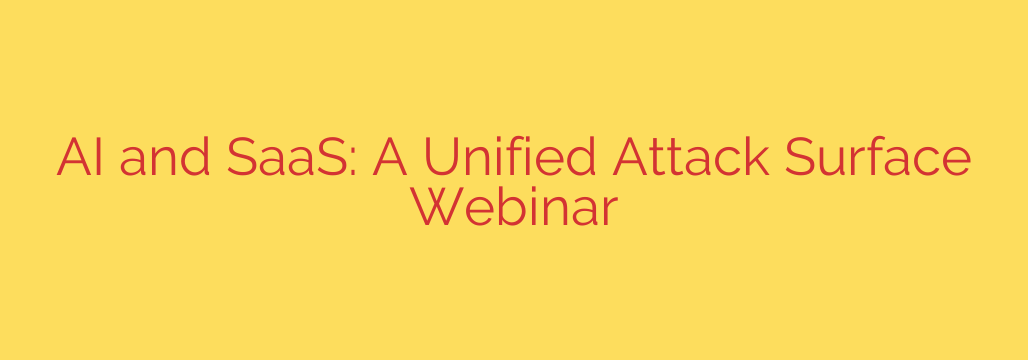
The New Frontier of Cyber Risk: Why AI and SaaS Security Are Now One
The rapid integration of generative AI into the workplace is transforming how businesses operate. From AI-powered assistants in Microsoft 365 to intelligent chatbots in customer relationship management (CRM) platforms, these tools promise unprecedented efficiency. However, this revolution brings a critical, often overlooked challenge: the merging of AI security and SaaS security into a single, unified attack surface.
Organizations can no longer treat the security of their cloud applications and their AI tools as separate disciplines. As AI becomes deeply embedded within the SaaS ecosystem, any vulnerability in one becomes a direct threat to the other. Understanding this unified risk is the first step toward building a resilient security posture for the modern enterprise.
The Blurring Lines: How AI and SaaS Became Intertwined
Think about how your teams work today. An employee might use a third-party AI tool to summarize sensitive meeting notes from a cloud-based document, or a marketing team might connect an AI content generator directly to their central content management system. In each case, the AI is not a standalone tool; it’s an extension of the SaaS platform, with access to its data and functions.
This seamless integration means that a traditional approach to SaaS security—focused on user permissions and network access—is no longer sufficient. Attackers now view your AI tools as a direct gateway into your most sensitive SaaS data, creating new vectors for data exfiltration, system manipulation, and corporate espionage.
Top Security Threats on the Unified AI-SaaS Attack Surface
When AI and SaaS converge, a new category of threats emerges. Security leaders must be prepared to defend against sophisticated attacks that exploit the trust between these interconnected systems.
Sensitive Data Exposure and Leakage
The most immediate risk is the unintentional leakage of confidential information. Employees, eager to leverage the power of AI, may copy and paste sensitive data—such as customer PII, financial reports, or proprietary source code—into public or insecure AI models. Without proper controls, your most valuable intellectual property could become part of a model’s training data, potentially accessible to other users or the model’s creators. This risk is magnified when AI tools are integrated directly into platforms like Slack or Salesforce, where vast amounts of sensitive data reside.Prompt Injection and Malicious Manipulation
Prompt injection is a sophisticated attack where a malicious actor crafts inputs designed to trick an LLM into bypassing its safety protocols. For example, an attacker could design a prompt that causes an AI integrated with your email system to forward private emails or execute unauthorized actions. A successful prompt injection attack can turn a helpful AI assistant into an insider threat, manipulating it to extract data, spread misinformation within the organization, or disable security functions.The Rise of “Shadow AI”
Just as “Shadow IT” created risks with unsanctioned software, “Shadow AI” poses a significant threat. This occurs when employees independently sign up for and integrate unvetted AI applications into their corporate SaaS tools without IT approval. Each unsanctioned integration creates a potential backdoor into your environment, granting an unknown third-party application access to your company’s data. These connections often have overly permissive access rights and lack proper security oversight, making them a prime target for attackers.
Actionable Steps to Secure Your Unified Environment
Protecting a unified AI and SaaS attack surface requires a proactive and integrated security strategy. Simply banning all AI tools is not a viable long-term solution. Instead, focus on establishing guardrails that enable safe and productive AI adoption.
- Gain Complete Visibility: You cannot protect what you cannot see. The first step is to map out all AI applications and integrations connected to your core SaaS platforms. This includes both officially sanctioned tools and potential instances of Shadow AI.
- Establish a Robust AI Governance Policy: Create clear guidelines for the acceptable use of AI. This policy should specify what types of data can be used with which AI models, outline the vetting process for new AI tools, and define data residency and privacy requirements.
- Enforce the Principle of Least Privilege: Ensure that AI applications and the user accounts connecting them have the absolute minimum level of access required to perform their intended function. Avoid granting broad, sweeping permissions that could allow a compromised AI tool to access unrelated sensitive data.
- Monitor and Detect Anomalous Activity: Implement security solutions that can monitor the flow of data between your SaaS applications and AI models. Look for signs of unusual activity, such as large-volume data transfers to a new AI tool or prompts that indicate attempts at malicious injection.
- Prioritize Employee Education: Your workforce is your first line of defense. Train employees on the risks of data leakage and prompt engineering, teaching them how to use AI tools responsibly and how to identify and report suspicious AI behavior.
The convergence of AI and SaaS is not a temporary trend—it is the future of business technology. By recognizing this unified attack surface and adopting a security framework that addresses its unique challenges, organizations can confidently embrace the power of AI without compromising their data or security.
Source: https://www.helpnetsecurity.com/2025/08/19/vorlon-webinar-ai-and-saas-attack-surface/








